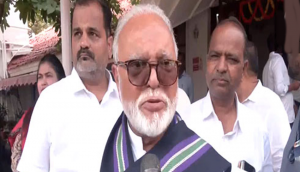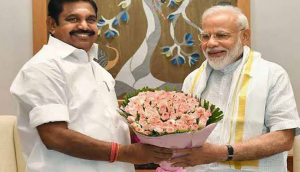Ashok Singhal: engineer, vocalist and the man behind the BJP's rise

The public face
- Ashok Singhal was the architect of the Ram Janmabhoomi movement and the Babri demolition
- He was an RSS pracharak and a well-known Muslim-baiter
The little-known side
- Singhal was a qualified metallurgical engineer from the Banaras Hindu University
- He was also a classical vocalist trained by the legendary Pandit Omkar Nath Thakur
More in the story
- How Singhal led to the rise of the BJP as a national power
- How his death will lead to a vacuum within the Vishwa Hindu Parishad
Ashok Singhal was a man of many parts, but most famous as a firebrand pracharak of the Rashtriya Swayamsevak Sangh. On Tuesday, 17 November, he died at the age of 89.
The working president of the Vishwa Hindu Parishad for over 20 years, Singhal was the principal architect of the Babri Masjid demolition on 6 December 1992. He galvanised Hindus and mobilised kar sewaks to pull down the disputed structure in Ayodhya.
It was a watershed moment for independent India - which tore apart the fabric of social harmony and saw the "rejuvenation" of Hindus.
An engineer and a vocalist
It may come as a surprise to most that Singhal was a metallurgical engineer from the Banaras Hindu University, and also a trained classical vocalist. He learnt the intricacies of music under the legendary Pandit Omkarnath Thakur.
But for the most part, Singhal preferred to sing a tune that never sounded musical to the ears of secularists and members of the minority community.
READ: How Modi 'admirer' Ashok Singhal has gone soft on Ram Mandir
Born on 15 September 1926, Singhal became an RSS volunteer in 1942, and a full-time pracharak soon after finishing his engineering degree from BHU. Uttar Pradesh, Delhi and Haryana were his focus areas; first as pracharak and then as praant pracharak.
Impressed by his organisational skills and oratory, the RSS deputed him to the VHP in 1980 as joint general secretary. Four years later, in 1984, the firebrand leader became its general secretary and, subsequently, its working president, a position he continued to hold till 2011. He had to relinquish that position due to failing health.
The Ram Janmabhoomi movement
In 1984, Singhal was one of the important organisers of the first dharm sansad at Vigyan Bhawan in New Delhi. The sansad, which was aimed at reviving Hinduism, sowed the seed for the Ram Janmabhoomi movement, to "liberate" the birthplace of Lord Ram.
As the spearhead of the movement, Singhal's idea to lay the foundation stone for a temple at a site adjacent to the mosque opened the floodgates to a controversy. This helped the BJP ride to power in Uttar Pradesh and, eventually, at the Centre.
Singhal learnt the intricacies of classical music under the legendary Pandit Omkarnath Thakur
It was Singhal's vision and fiery speeches that saw hordes of kar sewaks throng to Ayodhya from all corners of the country. Not just men, material too poured in from every part of the country for the proposed Ram temple. The karsewak puram in Ayodhya, where bricks and other paraphernalia needed for the temple gather dust, are a testimony to Singhal's ambitious plans that never materialised.
As Singhal pitchforked the VHP into the Ram temple movement, the body also gave a call to liberate the Kashi Vishwanath temple in Varanasi and the Krishna Janmabhoomi at Mathura.
Disenchantment, and the Modi 'revolution'
As temple construction plans began to go awry, after the title dispute and the Babri demolition went before court of law, the VHP's appeal began to wane among the masses. With disillusionment setting in, Singhal became disenchanted with the BJP for not being proactive towards keeping the promise of the Ram temple.
He was, however, hopeful that Narendra Modi's astounding victory in the Lok Sabha elections would provide a fillip to the temple construction programme. Singhal had described Modi's victory as an "end to 800 years of slavery", and had predicted that by 2020, India would be a Hindu nation, and by 2030, the world . In the BJP's victory he saw the beginning of a "revolution".
"This is not a modest revolution. It will not remain confined to India but present a new ideology before the world," the Hindu warrior had stated in July 2015.
Vacuum in the VHP
A hardline Hindu ideologue, Singhal was known as a Muslim baiter and never missed a chance to issue controversial statements. A few months before he described Modi's victory as "a revolution", he had asked Hindus to produce five children to ensure that Muslims don't overtake them in numbers. On cows too, Singhal wanted a law banning their slaughter.
If the BJP owes its rise to power to any one individual, it has to be Singhal, though many would say that LK Advani's rath yatra led to the build-up before demolition.
Singhal's death has created a vacuum in the VHP which Pravin Togadia, Singhal's successor, may find hard to fill. Not because Togadia is not virulent; but because he does not enjoy the same confidence of the present BJP dispensation as Singhal did.
The views expressed here are personal and do not necessarily reflect those of the organisation.
More in Catch:
#ParisAttacks: Let's face it, the West has made a mess
It's not a twin, but the Earth-like planet we just discovered is definitely family
Women should avoid dark roads: Alok Rawat, NCW's male member
Hamid Ansari warns India against becoming a majoritarian democracy
First published: 18 November 2015, 8:24 IST





![BJP's Kapil Mishra recreates Shankar Mahadevan’s ‘Breathless’ song to highlight Delhi pollution [WATCH] BJP's Kapil Mishra recreates Shankar Mahadevan’s ‘Breathless’ song to highlight Delhi pollution [WATCH]](https://images.catchnews.com/upload/2022/11/03/kapil-mishra_240884_300x172.png)

![Anupam Kher shares pictures of his toned body on 67th birthday [MUST SEE] Anupam Kher shares pictures of his toned body on 67th birthday [MUST SEE]](https://images.catchnews.com/upload/2022/03/07/Anupam_kher_231145_300x172.jpg)






